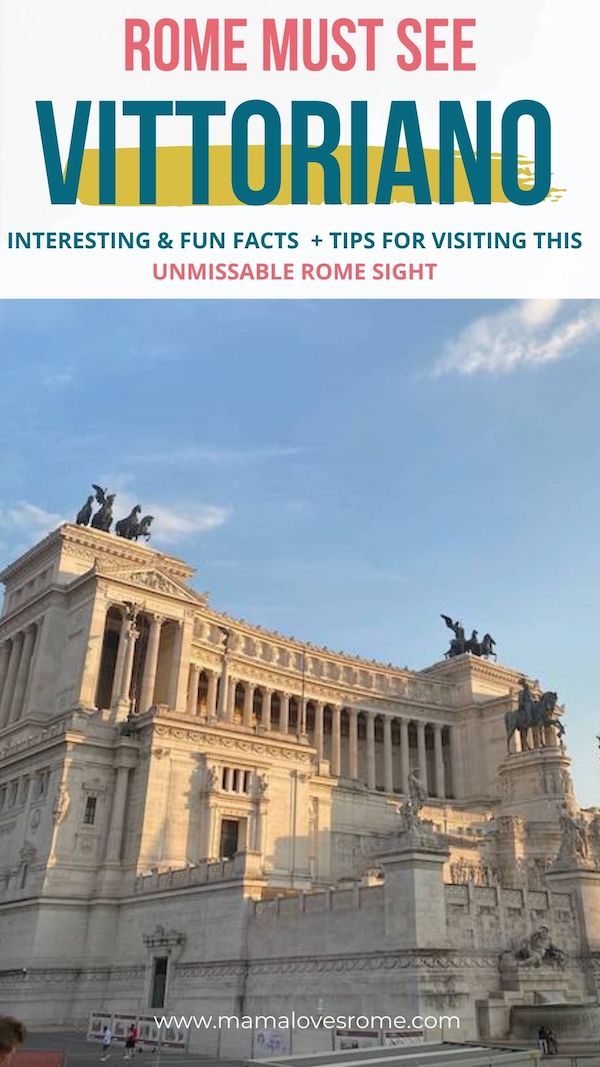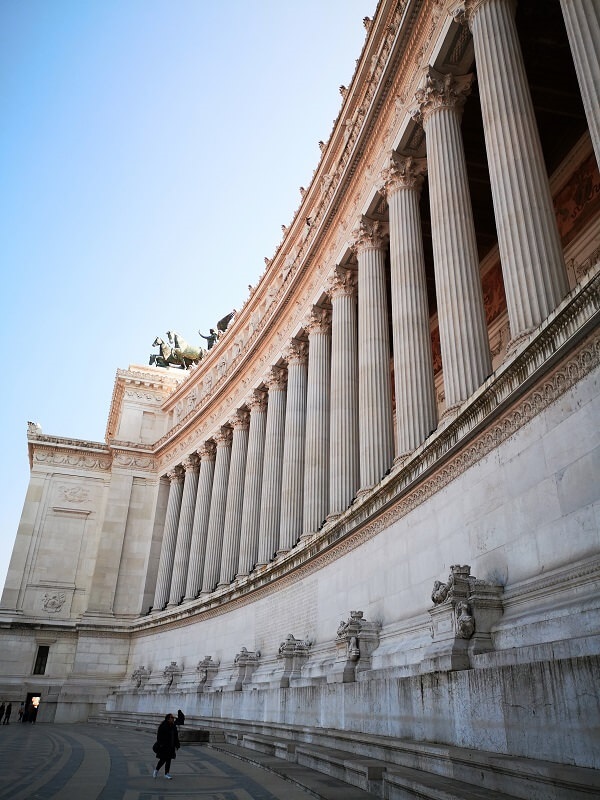All you need to know about the Vittoriano, Rome: how to visit, facts and practical info about one of Rome’s most peculiar monuments
Il Vittoriano, Monumento a Vittorio Emanuele II, or Altare della Patria (Altar to the Fatherland) is one of the most distinctive and controversial monuments in Rome.
It is a large neoclassical, big white building towering above Piazza Venezia, in Rome city center, and one you are unlikely to miss when visiting Rome.
Close to the Colosseum and the Roman Forum, just beside the Campidoglio and right at the entrance of Via del Corso, one of Rome’s city center main streets, you will at least pass it while walking around town and it is so big and attention-grabbing, there is no way you can pass by it an miss it!
Romans have mixed feelings about it: some love it, some hate it with a passion (many call it ‘the typewriter’, see below!) but no one can ignore it – it is just too big and too peculiar for that!
This is all you need to know about it and my best tips to plan a visit.
Love Pinterest? You can use this image to save this article for later!

What is Vittoriano and what is special about it
The Vittoriano is a large neoclassical monument built in Rome’s Piazza Venezia between 1885 e il 1911.
It was born as a celebratory monument to Vittorio Emanuele II, first King of Italy, and stands a symbol of patriotic sentiment and pride.
As well as celebrating the first King of united Italy, since the 1920s it is also the home to the tomb to the unknown soldier and currently hosts Museo del Risorgimento too, which contains memorabilia for the time of the fight to unify Italy.
As well as its importance, what makes the Vittoriano special is its distinctive appearance.
Huge and white, in stark contrast with anything else in its immediate surroundings and almost anything else in the city, the monument is an extravaganza of neoclassical architectural elements that, love it or hate it, is unique in the city!
The monument takes its name from its original purpose and it is often referred to as ‘Vittoriano’ (from King Vittorio Emanuele’s name) or Altare della Patria – lit. Altar to the fatherlands – although it also gained some lesser official denominations thanks to the wit of the locals: see below!
Vittoriano’s nicknames
Despite the solemn symbolism of the monuments, Romans were quick to find a nickname for this monument, by many considered a white monstrosity and an eyesore in an otherwise stunning area of ancient Rome.
Inspired by the peculiar shape of the monument, they decided to call it ‘the typewriter’ (la macchina da scrivere) a funny pet name that quickly gave birth to other ones such as the most common among English speakers: the wedding cake!
What to see at the Vittoriano
Il Vittoriano is made of three main parts: the main staircase, the colonnade and the two propylaea (the two tall sides), each, in turn, hosting several interesting details and attractions
The main staircase
The main Vittoriano staircase is the entrance to the monument and leads the visitors to various parts of the building both inside and out.

The staircase is protected by an elaborate metal gate and has two fountains at its sides.
The one East represents the Adriatic sea, from where the sun rises, and the one West represents the Tyrrhenian sea, where the sun sets, effectively symbolizing the natural borders of the Italian peninsula.
In the center of the main staircase, now sits the monument to the unknown soldier, brought here in the 1920a, as a memento against the horrors of war.
Good to know: The monument is now guarded by the Italian armed forces and you can see the change of the guards late in the morning when a small ceremony takes place (no tickets necessary, this is a short event you can easily miss it if you don’t know about it!)
Above the monument to the unknown soldier stands tall the Statue of Goddess Rome against the backdrop os a golden mosaic and with allegories of agriculture and industry, the engines of the Italian economy.
Effectively, the Vittoriano is in its whole an allegory of Italy and each part has a symbolic meaning.
Across the building, there are representations of, among others, strength, law, harmony, thought, action sacrifice, peace, unity and freedom.
All plants represented on the Vittoriano also are symbolic. Among the others, there is:
Palms: victory
Oak: strength
Laurel: valor
Myrtle: sacrifice
Olive tree: peace
The Equestrian Statue at Vittoriano Rome
At the center of the monument stands the equestrian statue of King Vittorio Emanuele II, placed on a tall podium decorated with the allegories of cities in Italy, to represent how important their support and cohesion is to the creating of the united state.
The statues is one of the most significant sculptures in Rome.

Fun fact: the equestrian statue is huge! 16 times bigger than a life-size horse and horseman, the statue hides a secret: the belly of the horse is empty and in 1919 hosted a dinner for 24 people!
The Colonnade
The next level up brings to the colonnade, made of 16 columns in Doric style.

The 16 columns represent the 16 regions that formed Italy at the time.
Each column is slightly different from the other just to remind the differences and therefore the richness and value each region contributed to the Italian identity.
At the two sides of the main colonnade, there are the two smaller porticoes called propylaea, each decorated with a quadriga and winged victory as a symbol of success.
The writing carved at their top reads ‘Civium Libertati’ (‘Citizens’ Freedom, right) and ‘Unity of the homeland” (‘Patriae Unitati’, left).
The Vittoriano terraces
Climbing farther up, we get to the first set of terraces.

Terrazza Italia, to the left, has stunning views over ancient Rome and allows you to see the Trajan’s markets and the Roman Forum, with the Colosseum in the background.
This is one of my favorite views over Rome and it is free.
Here you also have a cafe with light snacks and surprisingly reasonable prices, considering the location!
From here it is possible to climb even farther up via glass elevators: they bring you to the Terrazza delle Quadrighe (chariots pulled by horses, at the very top of the building), which has incredible all views over the whole city (the Vittoriano is over 80mt tall!)
Need to know: access to Terrazza delle Quadrighe is ticketed (access to the other areas is not) and tickets can be bought on the spot. The cost is 10 Euro at the time of writing.
Museums at Vittoriano Rome
The Vittoriano hosts several museums and exhibition spaces including:
Sacrario delle bandiere, the flags’ room with all the flags from divisions of the Italian army from the time of the Italian unity to the II world war.
Museum of Italian Resurgence (Museo del Risorgimento), with sections dedicated about some of the main actors in the events that lead to the Italian unity such as Garibaldi, Mazzini and Camillo Benso di Cavour and many photos and manuscripts from that time
Ala Brasini Wing – in the Brasini wing, several areas have been created to host high caliber exhibitions from all over the world. This has made the Vittoriano one of the most important exhibition spaces in the capital
How to get to Vittoriano
Il Vittoriano is in Piazza Venezia one of the largest and most important squares in Rome city center and trasnport hub.
Several buses have their terminus in the piazza, including 8, 44, 46, 60, 190, 780, 781, 810, 916, very many more stop here (C3, 40, 53, 80, 85, 63, 70, 81, 83, 87, 160, 170, 175, 186, 271, 628, 716, 810) and the tram also gets here from Trastevere, making this area very easy to reach from both parts of the river.
Metro B Colosseo is a short walk away too, about 5 minutes up Via dei Fori Imperiali.
What to see near the Vittoriano Rome
Vittoriano is right in the center of Rome and very many attractions are nearby. Among the most important:
Campidoglio Hill, just beside the Vittoriano, with Capitoline Museums, Michelangelo’s Piazza del Campidolgio and stuning views over the Roman forum
The Roman Forum, just beside
The Colosseum, only 5 minutes walk up the road
Via del Corso, one of Rome’s main shopping street is at the other end of Piazza Venezia
Trajan’s Column is just in front of the Vittoriano
The Pantheon and Piazza della Minerva are both a short walk away from Vittoriano
Vittoriano Rome Frequently Asked Questions
The Vittoriano was built between 1885 and 1911
The Altar to the fatherland (Altare della Patria) was born as a way to celebrate Vittorio Emanuele II, the first king of Italy, and therefore the newly obtained national unity. Nowadays is home to the tomb of the unknown soldier, a museum and several exhibition spaces.
The ‘wedding cake’ is the derogatory nicknames many give to the Vittoriano, the monument to Vittorio Emanuele II, the first king of Italy. The monument is considered by many an eyesore and the nickname was chosen because of the building is layered and white, like a wedding cake!
The typewriter is the nickname of one of Rome’s most famous monument, the Vittoriano or Altar to the Fatherland. the nickname comes from the peculiar shape of the building, which resembles and old style typewriter (the steps being the keys!)
Access to some parts of Altare della Patria is free: Terrazza Italia and the main staircase are free while the Terrazza delle Quadrighe and the temporary exhibition spaces have separate tickets.
I hope you enjoyed this quick overview of the Vittoriano monument and helped you learn more about this peculiar Rome attractions. Safe travel planning!

